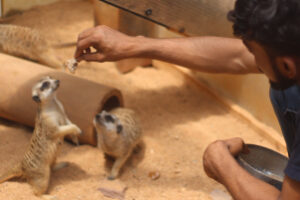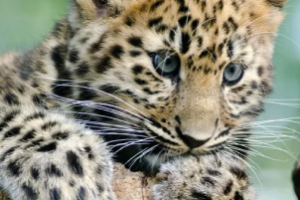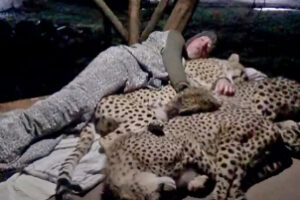
Small-scale breeding and harvesting of house cricket Acheta domesticus
E-ISSN: 2708-0021
P-ISSN: 2708-0013
www.actajournal.com
AEZ 2022; 3(2): 112-115
Received: 09-06-2022
Accepted: 11-07-2022
Soham Mukherjee
1.Life Science Education Trust, Bengaluru, Karnataka, India
2.WildRoost, Ahmedabad, Gujarat, India
Akanksha Mukherjee
1.Life Science Education Trust, Bengaluru, Karnataka, India
2.WildRoost, Ahmedabad, Gujarat, India
Corresponding Author:
Soham Mukherjee
1.Life Science Education Trust, Bengaluru, Karnataka, India
2.WildRoost, Ahmedabad, Gujarat, India
Soham Mukherjee and Akanksha Mukherjee
DOI: https://doi.org/10.33545/27080013.2022.v3.i2b.82
Abstract
Insectivorous animals in captivity must have access to a consistent supply of live food that is both plentiful and fresh. House crickets are a nutrient-dense source of essential amino acids, carbohydrates, fats, minerals, and water, as well as a rich source of protein. Unfortunately, because feeder crickets are not widely available commercially in India, purchasing crickets for this purpose is not yet an option. Due to the demanding maintenance needed by traditional methods, many people who try to breed crickets in a home environment fail over time. With the method described in this article, it is possible to produce large quantities of crickets affordably, consistently, and with fair ease.
Keywords: House cricket, feeder insect, breeding
Introduction
Probably originating in Southwestern Asia, the house cricket Acheta domesticus, spread throughout the world between 1950 and 2000 after becoming the preferred feeder insect for the pet and research industries [1,2]. More recently, their potential nutritional value in human diets has been recognized, making them one of the most significant species of industrialized insects in many countries [3,4]. The focus of this article remains on the use of house crickets as feeder insects for captive insectivore animals. They are easily digestible and provide excellent roughage for insectivorous pets and animals in rehabilitation. In addition to their obvious nutritional value, crickets play a vital role in stimulating an animal’s natural hunting instincts and improving its quality of life. Crickets are suitable for mass rearing, multiply quickly and form large populations, have a low risk of zoonotic diseases, have an extremely high feed conversion ratio, and are simple and inexpensive to breed.
Materials and Methods
Use of pre-existing household containers, such as fish tanks, plastic tubs, or unused storage containers, is an option for small-scale production. Special, purpose-built containers will need to be built in order to increase production. Height is the most important consideration when selecting a container [5]. The authors typically use containers that are 60 cm x 40 cm x 40 cm in size (LxBxH). However, the advantages of a container with higher sides are greater. Additional height permits vertical placement of large egg cartons in the container. Large 25cm x 25cm square egg cartons can be placed inside without cutting. These containers are large enough to hold 500 to 700 adult crickets with minimal cannibalism. The higher sides provide enough height at the top to reduce the number of crickets that will likely jump out when the container is opened. There should be about 10 to 15 cm of space between the top of the carton and the lid [5]. Ventilation vent can be cut into the lid, and a fine mesh should be affixed. To prevent crickets from crawling out, a container made of smooth plastic material should be used (Fig 1). The containers should not be excessively heavy or cumbersome so that they can be easily moved and cleaned as needed. As nocturnal insects, crickets feel more secure in opaque containers and prefer to lay eggs in darkness [6]. The containers should have good ventilation and should be escape proof [5]. Additionally, vermiculite, shallow dishes for feeding and water, egg cartons, and plastic dishes filled with damp vermiculite for egglaying are required. Vaseline petroleum jelly can be used as a barrier cream to prevent crickets from climbing out of the container.
Biology and Behaviour
House crickets are insects that belong to the Orthoptera order and Gryllidae family. Crickets are omnivores, consuming both plant and animal matter [7]. Depending on temperature and environmental conditions, their average lifespan is between two and three months [5] . At a temperature of 32 degrees Celsius, the duration from egg to adult is 6-7 weeks. There are ten molts throughout development [8]. Higher temperatures will decrease their lifespan but increase their growth rate, whereas lower temperatures will result in greater adult body mass [9]. The life cycle of house crickets is typical. Male actively pursues female, attracting her with a chirping sound produced by rubbing the serrated edges of his forewings (stridulation). When a male poses a threat, swift chirping is produced, whereas slower chirping is used to attract a female for mating [10]. After copulation, the female lays fertile eggs into moist soil or organic material (vermiculite in egg-laying dish) at approximately 1 cm depth. When conditions are favourable, house crickets can lay eggs every two weeks for the majority of their adult lives. Productive females are capable of laying roughly 200 eggs per batch [11]
.
Approximately 2 to 3 mm in length, the eggs are whitish/yellowish in colour. A female cricket can lay 600 or more eggs throughout her lifetime [12]. At 30 degrees Celsius, eggs hatch in around 13 days [11]. At hatching they are called pinheads and are small replicas of their parents that are approximately 2 to 3 mm in length. The young pinheads grow rapidly and regularly shed their skin (molt).The growth stages of a cricket are 2 to 3 mm pinheads, 10 mm small crickets, 10 to 20 mm medium crickets, and 20 to 30 mm large crickets. Although they can survive a range of temperatures, they reproduce and grow most effectively when temperatures are consistently between 32 and 35 degrees Celsius.
Arrange the cartons vertically along the length of the container. In the empty space next to the egg cartons, place the egg-laying dish, feed dish, and water dish (Fig 3A). If the container is smaller than previously recommended (height less than 30 cm), the egg cartons should be placed horizontally (Fig 3B). For water requirements, chemicalfree water gel can be used and placed in a shallow plastic container. In the absence of water gel, a non-toxic wet sponge can be placed in the water dish. Because pinheads are prone to drowning, it is important to avoid using water directly. Place all newly captured and collected crickets in the container with pre-arranged egg cartons for hides. Place a shallow dish of commercial cricket food or a suitable substitute, such as crushed premium dry cat food, in the container. Place another dish for presenting fresh fruits and vegetables. Place the egg-laying dish, a 2 to 3 in deep plastic dish containing moist (but not dripping) vermiculite. Once crickets begin laying eggs (Fig 3C), the eggs will begin to hatch in approximately two weeks. Once pinheads begin to emerge from the egg-laying dish (Fig 3D), the dish along with the pinheads should be transferred to a rearing container. A rearing container is a separate container that does not contain any adult crickets. At 14 days (two weeks) after hatching, the pinheads begin nibbling. Their metabolic system begins to function at this age, but prior to this, they rely heavily on nutrients from the egg [13]. The nymphs go through ten instars before reaching adulthood, depending on diet, humidity, and temperature.
Starting a Breeding Set-up
As a substrate, add 1-3 inches of vermiculite to the bottom of the container. Substrate must be replaced every 2 to 6 months depending on cricket density. Obtain 20-40 mature crickets; keep more females and less males (Fig 2). These crickets can be wild-caught and collected from common hiding places in human landscapes. It is critical to avoidcollecting from polluted areas or places with risks of being exposed to environmental toxins.
Daily Care
One of the most overlooked aspects of breeding and rearing crickets is the daily care and maintenance of the culture. Monitoring the overall condition of the container and preventing pests such as ants, micro-flies, moths, beetles, etc. are daily responsibilities. Daily husbandry tasks include providing food, moistening sponges, spraying (especially in dry weather), basic cleaning, removing dead or injured crickets, and monitoring overcrowding, among others. The culture room should be adequately ventilated, dark, and warm (30 degrees Celsius on an average).
Food and Water
For optimal growth, crickets require a well-balanced diet. A balanced cricket diet should include both macro and micronutrients like protein, lipids, and carbohydrates, vitamins, and minerals [14]. The feed should ensure high survivability and a longer lifespan, resulting in lower mortality due to diet quality. A poor diet makes crickets more susceptible to diseases and parasites. Appropriate nutrition contributes to high fertility in order to sustain production and shorten the period of development. The quality of the feed also determines the nutritional value and size of the crickets. Lastly, a healthy feeding schedule reduces cannibalism. Crickets fed a poor diet will cannibalise to compensate for a lack of nutrients. The authors typically use powdered dry dog and cat food pellets mixed with calcium powder. Every alternate day, wet food in the form of fruits: orange, apple, pear, melon, etc. and vegetables: pumpkin, carrot, cucumber, beet, peas, spinach, etc. is provided in addition to the dry food. Once or twice a week, food such as mixed sprouts can be provided. Crickets are short and can drown if their drinking water dish is too deep. There are several methods for safely providing moisture to crickets. Because pinhead crickets can drown easily in a water dish, they are only given fresh veggies/fruit slices every day as a water source until they are larger in size. These must be removed from the previous day and replaced on a daily basis. Wet sponge can be used as a water source for baby crickets that are 10 mm or larger. Adult crickets can be fed water gel or crystals, or a dish with a sponge soaked in water or a water dish filled with pebbles to keep them from drowning. Smaller poultry waterers with sponge can be used for less frequent watering. The crickets will consume a portion of the water-soaked sponge, which will need to be replaced on a regular basis.
Harvesting
It is much easier to harvest the required sized crickets if the cricket culture is size sorted in labelled containers. If a small number of crickets must be harvested, remove one or two egg cartons from the target container and empty them into a separate, 30 cm deep empty plastic container with smooth sides. Once the crickets have been emptied, they can be caught with tweezers or by hand, whichever is more appropriate for the task. A special device can be custommade for easy and quick cricket harvesting in large numbers. This device requires a funnel with a diameter of 20 cm (or in proportion to the size of the egg cartons), a cylindrical plastic jar with the same diameter as the funnel and a depth of 30 cm, a hard plastic sheet with dimensions of 10 cm x 10 cm (LxB), and a cylindrical plastic container with a diameter of 6 cm and a depth of 15 cm. The narrow end of the funnel is glued in place after being passed
Conclusion Breeding crickets is relatively simple, and in fact, raising one’s own feeder crickets can be less expensive and timeconsuming than purchasing them from a local supplier. As feeder insects are not readily available commercially in India, raising crickets gives control over one’s pet’s diet and eliminates the need to rely on cricket suppliers. With a few simple steps and equipment, one can produce their own supply of feeder crickets in a matter of weeks.
References
1. 2004. https://web.archive.org/web/20040623151002/http://crawford.tardigrade.net/bugs/cricketsuppl.html. (Accessed October 6, 2022)
2. https://entnemdept.ufl.edu/creatures/misc/crickets/adomest.html. (Accessed October 6, 2022)
3. Morales-Ramos JA, Rojas MG, Dossey AT, Berhow M.Plos One. 2020;15(1):e0227400.
4. Collavo A, Glew RH, Huang YS, Chuang LT, Bosse R, Paoletti M. House Cricket Small-scale Farming. Ecological Implications of Minilivestock: Potential of Insects, Rodents, Frogs and Snails; c2005.
5. Kvassay G. The Complete Cricket Breeding Manual: Revolutionary New Cricket Breeding Systems. // Zega Enterprises; c2014. p. 164.
6. Cymborowski B. Journal of Insect Physiology. 1973;19(7):1423-1440.
7. https://www.eol.org/pages/500901. (Accessed October 7, 2022)
8. Patton RL. Annals of the Entomological Society of America. 1978;71(1):40–42.
9. Booth DT, Kiddell K. Journal of Insect Physiology.2007;53(9):950–953.




